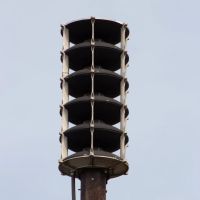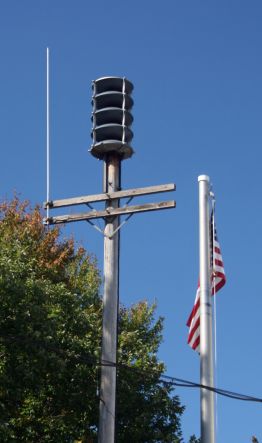WPS-2700: Difference between revisions
No edit summary |
TheCamWheel (talk | contribs) mNo edit summary |
||
| (19 intermediate revisions by 2 users not shown) | |||
| Line 1: | Line 1: | ||
{{ | {{Infobox siren|title=Whelen WPS-2700|image=Americana2750Cropped.jpg|thumb|caption=A 1st Generation Whelen WPS-2750 located in Branson, MO.|company=[[Whelen Engineering]]|produced=1987-1991|type=[[Omnidirectional]] [[Electronic]]|output=109-121 dB @ 100 feet|voltage=24|wattage=800-3600 W|current=DC|preceded=[[Whelen WS-2000]]|succeeded=[[Whelen WPS-2800]]|manual=https://drive.google.com/file/d/164s44NFr-QSyqqERtepAjlveZ2Xi9Df-/view?usp=sharing}}The '''WPS-2700''' is a series of modular multicellular electronic sirens that was produced by [[Whelen Engineering]]. It was a revolutionary design for its time and Whelen still sells very similar sirens to this day. The WPS-2700 was the first multicellular electronic siren, a design type that has proven to be very popular in modern times. | ||
| | |||
|image= | |||
|caption= A WPS- | |||
|produced= 1987-1991 | |||
|type=[[Electronic]] | |||
|output= 109-121 | |||
|succeeded=[[WPS-2800 | |||
| | |||
}} | |||
The '''WPS-2700 | |||
The WPS-2700 series would only be produced for 4 years, being replaced in 1991 by the [[Whelen WPS-2800|WPS-2800]] series, which significantly improved upon the design and allowed for more cells to be stacked than the WPS-2700 as the newly released controllers allowed for them. The WPS-2700 was also sold alongside the older directional WPS-2000 series, which was cheaper and easier to maintain. Today, several WPS-2700 units can still be found in service, most having their old analog ESC-864 controllers replaced by newer digital ESC-2020 and ESC-2030 controllers. Others have been replaced by newer electronic sirens, often [[Whelen WPS-2900|WPS-2900]] or [[Whelen WPS-4000|WPS-4000]] sirens. | |||
== | == History and design == | ||
The model | [[File:WPS-2740 Columbiana.jpg|thumb|262px|A 2nd Generation Whelen WPS-2740 in Columbiana, OH.]] | ||
{ | The WPS-2700 series was first introduced in 1987 and was designed by Bruce Howze, who had previously designed the [[Whelen WS-2000|WS-2500]]. While the WS-2500 never entered production, its concept was good enough that it was eventually developed into the WPS-2700. It used a then-revolutionary new design, using modular stacked cells containing the compression drivers instead of regular speakers. This new design allowed the sound to be projected in a true 360 fashion, with no dead zones. This made it great for voice message broadcasting. Each siren came with battery backup and solar capabilities, allowing it to run without direct power. | ||
| | |||
| | Each WPS-2700 unit is made of a varying number of cells, with the number of cells dictating the siren's model number. Unlike the later stacked cell Whelens, the WPS-2700 uses a different naming scheme where the number of cells is in the tens column, instead of the ones column. Thus, a WPS-2700 with 5 cells would be a WPS-2750, instead of a WPS-2705. Each cell is made of fiberglass and has two elliptical surfaces with a projector and screen in between, with a 400 W "Superpower" compression speaker driver located inside the bottom of each cell. Each cell is supported by four or six aluminum supports, with a small screen around where the sound output is located in the middle of the cell. The sound is projected upwards from the bottom of each cell and projected by a conical projector and the shape of the cells themselves. The screen is small, similar to the later [[Whelen WPS-2900|WPS-2900]] series. Prior to release, the prototype utilized four aluminum supports, which was quickly changed to six during the final release. Somewhere between the late 80s and early 90s, they implemented the four supports yet again, similarly to the prototype. | ||
| | |||
| | There were four configurations originally advertised by Whelen, with 3, 4 and 5 cell models available: the WPS-2730, WPS-2740 and WPS-2750 respectively. However, other configurations were available as well, such as the dual-cell WPS-2720, six-celled WPS-2760, and the largest option supported by the controller, the 9-celled WPS-2790. These weren't advertised until later on in the series' production. It is speculated that the WPS-2760 was the direct replacement for the WPS-2790, due to its lower power consumption and similar performance per watt, which also allowed for a less expensive controller with fewer amps and drivers needed. A mobile version of the WPS-2740 was also available, named the WPS-2740 Mobile Command Post. It consisted of a WPS-2740 on a hydraulic arm attached to a trailer, allowing it to be deployed anywhere. No WPS-2710, WPS-2770, or WPS-2780 units were ever known to have been produced or exist. | ||
| | {| class="mw-collapsible fandom-table" | ||
| | |+Whelen WPS-2700 models | ||
| | !Model | ||
| | !dB @ 100ft | ||
| | !Number of drivers | ||
| | |- | ||
| | |WPS-2720 | ||
| | |109 dB | ||
| | |2 | ||
| | |- | ||
| | |WPS-2730 | ||
| | |112 dB | ||
| | |3 | ||
| | |- | ||
|WPS-2740 | |||
|115 dB | |||
|4 | |||
|- | |||
|WPS-2750 | |||
|118 dB | |||
|5 | |||
|- | |||
|WPS-2760 | |||
|119 dB | |||
|6 | |||
|- | |||
|WPS-2790 | |||
|121 dB | |||
|9 | |||
|} | |||
== Example videos == | == Example videos == | ||
* {{Link-inline-video |link=wHEtaPNxxSI |name=A WPS-2740 with an older analog ESC-864 controller, | * {{Link-inline-video |link=wHEtaPNxxSI |name=A Whelen WPS-2740 with an older analog ESC-864 controller, during a noon blast.}} | ||
[[Category:Omnidirectional Sirens]][[Category:Electronic Sirens]][[Category:Single Toned Sirens]][[Category:Dual Toned Sirens]][[Category:Whelen Engineering]][[Category:Sirens]] | [[Category:Omnidirectional Sirens]][[Category:Electronic Sirens]][[Category:Single Toned Sirens]][[Category:Dual Toned Sirens]][[Category:Whelen Engineering]][[Category:Sirens]] | ||
__INDEX__ | |||
Latest revision as of 01:27, 4 November 2024
| Whelen WPS-2700 | |
 A 1st Generation Whelen WPS-2750 located in Branson, MO. | |
| Company | Whelen Engineering |
|---|---|
| Produced | 1987-1991 |
| Type | Omnidirectional Electronic |
| Sound output | 109-121 dB @ 100 feet |
| Wattage | 800-3600 W |
| Voltage | 24 V DC |
| Preceded by | Whelen WS-2000 |
| Succeeded by | Whelen WPS-2800 |
| Documentation | Manual |
The WPS-2700 is a series of modular multicellular electronic sirens that was produced by Whelen Engineering. It was a revolutionary design for its time and Whelen still sells very similar sirens to this day. The WPS-2700 was the first multicellular electronic siren, a design type that has proven to be very popular in modern times.
The WPS-2700 series would only be produced for 4 years, being replaced in 1991 by the WPS-2800 series, which significantly improved upon the design and allowed for more cells to be stacked than the WPS-2700 as the newly released controllers allowed for them. The WPS-2700 was also sold alongside the older directional WPS-2000 series, which was cheaper and easier to maintain. Today, several WPS-2700 units can still be found in service, most having their old analog ESC-864 controllers replaced by newer digital ESC-2020 and ESC-2030 controllers. Others have been replaced by newer electronic sirens, often WPS-2900 or WPS-4000 sirens.
History and design

The WPS-2700 series was first introduced in 1987 and was designed by Bruce Howze, who had previously designed the WS-2500. While the WS-2500 never entered production, its concept was good enough that it was eventually developed into the WPS-2700. It used a then-revolutionary new design, using modular stacked cells containing the compression drivers instead of regular speakers. This new design allowed the sound to be projected in a true 360 fashion, with no dead zones. This made it great for voice message broadcasting. Each siren came with battery backup and solar capabilities, allowing it to run without direct power.
Each WPS-2700 unit is made of a varying number of cells, with the number of cells dictating the siren's model number. Unlike the later stacked cell Whelens, the WPS-2700 uses a different naming scheme where the number of cells is in the tens column, instead of the ones column. Thus, a WPS-2700 with 5 cells would be a WPS-2750, instead of a WPS-2705. Each cell is made of fiberglass and has two elliptical surfaces with a projector and screen in between, with a 400 W "Superpower" compression speaker driver located inside the bottom of each cell. Each cell is supported by four or six aluminum supports, with a small screen around where the sound output is located in the middle of the cell. The sound is projected upwards from the bottom of each cell and projected by a conical projector and the shape of the cells themselves. The screen is small, similar to the later WPS-2900 series. Prior to release, the prototype utilized four aluminum supports, which was quickly changed to six during the final release. Somewhere between the late 80s and early 90s, they implemented the four supports yet again, similarly to the prototype.
There were four configurations originally advertised by Whelen, with 3, 4 and 5 cell models available: the WPS-2730, WPS-2740 and WPS-2750 respectively. However, other configurations were available as well, such as the dual-cell WPS-2720, six-celled WPS-2760, and the largest option supported by the controller, the 9-celled WPS-2790. These weren't advertised until later on in the series' production. It is speculated that the WPS-2760 was the direct replacement for the WPS-2790, due to its lower power consumption and similar performance per watt, which also allowed for a less expensive controller with fewer amps and drivers needed. A mobile version of the WPS-2740 was also available, named the WPS-2740 Mobile Command Post. It consisted of a WPS-2740 on a hydraulic arm attached to a trailer, allowing it to be deployed anywhere. No WPS-2710, WPS-2770, or WPS-2780 units were ever known to have been produced or exist.
| Model | dB @ 100ft | Number of drivers |
|---|---|---|
| WPS-2720 | 109 dB | 2 |
| WPS-2730 | 112 dB | 3 |
| WPS-2740 | 115 dB | 4 |
| WPS-2750 | 118 dB | 5 |
| WPS-2760 | 119 dB | 6 |
| WPS-2790 | 121 dB | 9 |